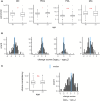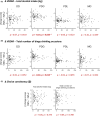Higher alcohol use is associated with subsequent increased risk seeking toward gains: A longitudinal cohort study in young men
- PMID: 40252008
- PMCID: PMC12174501
- DOI: 10.1111/acer.70051
Higher alcohol use is associated with subsequent increased risk seeking toward gains: A longitudinal cohort study in young men
Abstract
Background: A higher propensity for impulsive and risky choices has often been reported in individuals with addiction, such as alcohol use disorder (AUD). Although domains of choice impulsivity, for example, temporal discounting, have been identified to predispose the development of hazardous alcohol use, research on altered decision making as a consequence of drinking is scarce. These may be particularly pronounced during periods of progressive brain development, such as young adulthood.
Methods: This 3-year prospective study investigated the effects of alcohol use on changes in four decision-making domains in 18-year-old men (N = 130). We assessed temporal changes in discounting of delayed rewards, risk aversion for gains, risk seeking for losses, and loss aversion. By correlating three-year cumulative alcohol consumption and total binge drinking frequency with respective change scores, we aimed to explore the influences of drinking on altered development in different impulsive choice tendencies.
Results: From ages 18 to 21, choice impulsivity in our moderately drinking cohort decreased significantly with respect to temporal discounting and risk aversion for gains, while risk seeking for losses and loss aversion did not change significantly. Importantly, higher cumulative alcohol intake and more binge drinking occasions over 3 years were associated with slower increases in risk aversion for gains, that is, the general trend for lower choice impulsivity was diminished. Such relationships were not found for temporal discounting, risk seeking for losses, or loss aversion.
Conclusions: Alcohol consumption in young adulthood is linked to stunted development of risk aversion for gains. Given that risk seeking for gains was previously identified as a risk factor for increasing alcohol intake, this relationship may reinforce a spiral of escalating consumption over time. The absence of similar findings in other decision-making domains suggests that drinking behavior and modifying factors interact differently across domains, rather than universally enhancing impulsive choice behavior.
Keywords: alcohol use; decision making; delay discounting; loss aversion; risk taking.
© 2025 The Author(s). Alcohol, Clinical and Experimental Research published by Wiley Periodicals LLC on behalf of Research Society on Alcohol.
Conflict of interest statement
The authors declare no conflicts of interest.
Figures




Similar articles
-
The impact of adolescent drinking on traumatic brain injury-induced cognitive deficits and alcohol preference in adult C57BL/6J mice.Alcohol Clin Exp Res (Hoboken). 2025 May;49(5):1013-1027. doi: 10.1111/acer.70027. Epub 2025 Mar 23. Alcohol Clin Exp Res (Hoboken). 2025. PMID: 40123100
-
Experimental reductions of delay discounting and impulsive choice: A systematic review and meta-analysis.J Exp Psychol Gen. 2018 Sep;147(9):1349-1381. doi: 10.1037/xge0000462. J Exp Psychol Gen. 2018. PMID: 30148386 Free PMC article.
-
Effect of Acute Alcohol Consumption in a Novel Rodent Model of Decision Making.bioRxiv [Preprint]. 2024 Sep 26:2024.09.24.614857. doi: 10.1101/2024.09.24.614857. bioRxiv. 2024. Update in: Alcohol Alcohol. 2025 Mar 25;60(3):agaf017. doi: 10.1093/alcalc/agaf017. PMID: 39386642 Free PMC article. Updated. Preprint.
-
Stress and episodic future thinking: Effects on temporal window and alcohol demand.Alcohol Clin Exp Res (Hoboken). 2025 Jun;49(6):1351-1363. doi: 10.1111/acer.70058. Epub 2025 Apr 19. Alcohol Clin Exp Res (Hoboken). 2025. PMID: 40251998 Free PMC article.
-
Assessing the comparative effects of interventions in COPD: a tutorial on network meta-analysis for clinicians.Respir Res. 2024 Dec 21;25(1):438. doi: 10.1186/s12931-024-03056-x. Respir Res. 2024. PMID: 39709425 Free PMC article. Review.
References
-
- American Psychiatric Association . (2013) Diagnostic and statistical manual of mental disorders. Washington, DC: American Psychiatric Publishing, a division of American Psychiatric Association.
-
- Audrain‐McGovern, J. , Rodriguez, D. , Epstein, L.H. , Cuevas, J. , Rodgers, K. & Wileyto, E.P. (2009) Does delay discounting play an etiological role in smoking or is it a consequence of smoking? Drug and Alcohol Dependence, 103(3), 99–106. Available from: 10.1016/j.drugalcdep.2008.12.019 - DOI - PMC - PubMed
-
- Barsky, R.B. , Juster, F.T. , Kimball, M.S. & Shapiro, M.D. (1997) Preference parameters and behavioral heterogeneity: an experimental approach in the health and retirement study*. The Quarterly Journal of Economics, 112(2), 537–579. Available from: 10.1162/003355397555280 - DOI
-
- Bernhardt, N. , Nebe, S. , Pooseh, S. , Sebold, M. , Sommer, C. , Birkenstock, J. et al. (2017) Impulsive decision making in young adult social drinkers and detoxified alcohol‐dependent patients: a cross‐sectional and longitudinal study. Alcoholism, Clinical and Experimental Research, 41(10), 1794–1807. Available from: 10.1111/acer.13481 - DOI - PubMed
MeSH terms
Grants and funding
LinkOut - more resources
Full Text Sources
Medical

